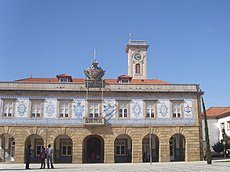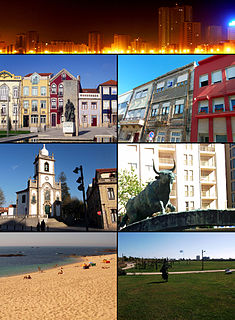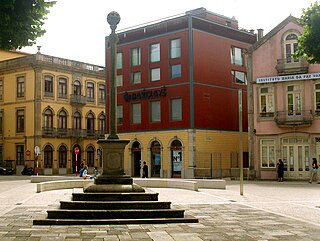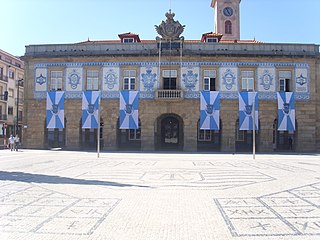
Póvoa de Varzim' is served by a transportation network that employs maritime, aerial and terrestrial travel. The terrestrial access infrastructure is composed of national motorways (freeways), the national roads system, and light rail metro. These infrastructures and the airport, bus terminal, marina and harbour are daily used by commuters.
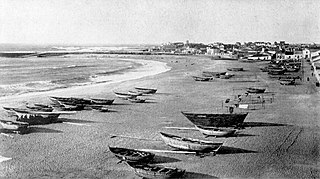
Póvoa de Varzim is a former Portuguese civil parish, located in the city of Póvoa de Varzim. It is the core of the city of Póvoa de Varzim and until the new city limits established in 1995 it was the single parish that made up the city. In the census of 2011, it had a population of 28,420 inhabitants and a total area of 5.25 km². A 2012 law merged the parish with neighbouring Argivai and Beiriz, becoming the southern parish of the city of Póvoa de Varzim, known as União das Freguesias da Póvoa de Varzim, Beiriz e Argivai.

Agro-Velho, historically and popularly known as Nova Póvoa, is one of the eleven officially designated districts located in the Portuguese city of Póvoa de Varzim. It is a beach resort district located around Lagoa Cove.

Rua da Junqueira, mostly known simply as Junqueira, is a traditional shopping street in Póvoa de Varzim in Portugal. The street, located in Póvoa de Varzim City Center, it is the main and the oldest shopping street of the city, with several boutiques, some opened for over 100 years, and small shopping centers. Historic architecture was preserved and it is also the most popular tourist area outside the beach in Póvoa de Varzim, attracting millions of visitors. It is a landmark for the city and neighboring areas.
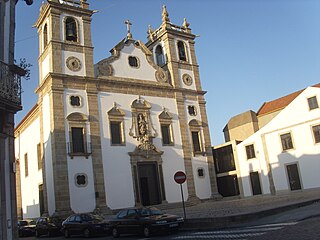
Bairro da Matriz is the historical neighbourhood of the Portuguese city of Póvoa de Varzim and part of the Matriz/Mariadeira district.

Matriz Church of Póvoa de Varzim, also Nossa Senhora da Conceição Parish Church is the Mother Roman Catholic church in Póvoa de Varzim, Portugal. The temple is located in Praça Velha square, in Bairro da Matriz quarter. The church is dedicated to the Our Lady of the Immaculate Conception, Nossa Senhora da Conceição in Portuguese, the main patron saint of Póvoa de Varzim.

Reinaldo Oudinot was a French military engineer from the 18th century, who became most famous for his hydraulic works on the Portuguese harbours of Porto, Aveiro, Leiria and Funchal. Even though he was born and educated in France, he started his career in Portugal, where he developed several projects on different fields such as: architecture, urban planning, hydraulic engineering and agriculture development. In 1803, he was to become one of the most ranked engineers on the Portuguese army as he was promoted to Brigadier of the Royal Engineers.

Praça da República, formerly named Largo de São Roque is a small square in the city of Póvoa de Varzim in Portugal.
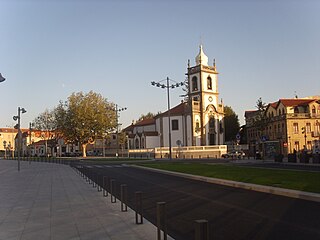
Largo das Dores or Dores Square is a square in Póvoa de Varzim city center in Portugal. Part of the earliest old town of Póvoa de Varzim, this area is listed by City Hall as heritage site. With about 11.000 square meters, its most noticeable features are its two churches, located in the sites of ancient chapels, one of which was the main church of the city.

The history of Póvoa de Varzim, Portugal, and its development as a maritime trade and fishing hub, have been greatly influenced by its location at the entrance to one of Portugal's best natural ports.
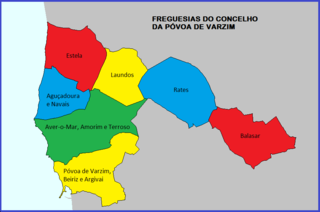
Póvoa de Varzim is divided into seven civil parishes, most of which were created as civil entities in the 19th century and some were merged in the 21st century, but are directly derived from ecclesiastical parishes existing since the Early Middle Ages. These parishes are grouped into three areas recognized by the Municipal masterplan: urban (city), suburban and rural.

The Port of Póvoa de Varzim is a seaport built in Enseada da Póvoa Bay in the city of Póvoa de Varzim in Portugal. During the Middle Ages, it was known as Port of Varzim.

Alminhas or Nichos de Alminhas do Purgatório are a type of wayside shrine typical of Póvoa de Varzim, Portugal. These small shrines are mostly urban and represent souls in Purgatory.
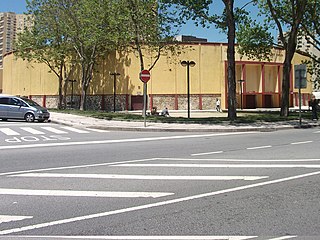
Póvoa de Varzim Bullfighting Arena is a bullring in Póvoa de Varzim, Portugal. It is located in Avenida Vasco da Gama avenue, in the northern waterfront of the city. Bullfighting, horse shows, and concerts are held in the arena.

The architecture of Póvoa de Varzim, in Portugal, demonstrates a broad variety of architectural styles over its thousand years of history. 11th-century Romanesque, 16th-century Mannerism, 18th-century Baroque, late 18th-century neoclassicism, early 20th-century Portuguese modernism and late 20th- to early 21st-century contemporary architectural styles and more are all represented in Póvoa de Varzim. As a whole it represents a rich eclectic tradition and innovation shaped by the people, their beliefs and economy.

Avenida Vasco da Gama is a street in the north central area of Póvoa de Varzim, Portugal. It is one of the main avenues in the city, with hotels, banks, sports areas, bars and is the location in the city with most high-rises. It runs from Avenida do Mar, expansion of the avenue to A28 Motorway (freeway), and Rua Gomes de Amorim to Avenida dos Banhos in the waterfront. It has some of Póvoa de Varzim's most famous landmarks such as Touro and Póvoa de Varzim Bullring.
